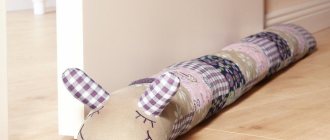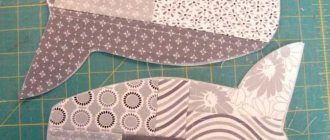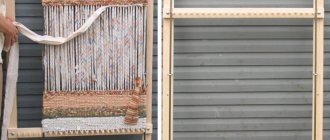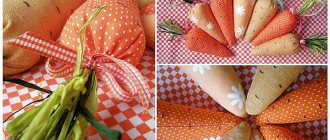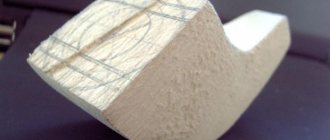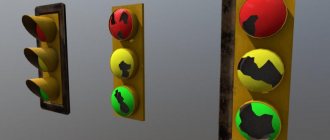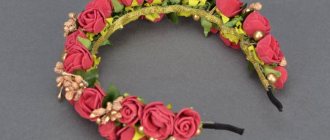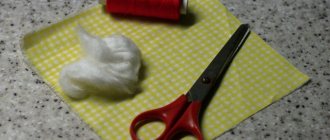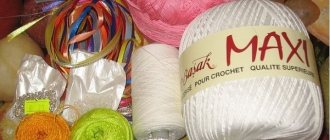creativecommons.org
All knitters face the problem of storing tools. You constantly have to look for knitting needles and hooks in drawers and on shelves. Moreover, it is not always possible to find the necessary equipment on time. A convenient organizer – a pencil case with pockets and special compartments – helps to avoid the problem. Finding a comfortable item on sale is difficult. Size, number of pockets or design does not fit. It is much easier to take care of your own comfort. To do this, you can knit an original tool stand with your own hands.
How to knit a pencil case for knitting needles and hooks with your own hands: diagram
A non-standard knitted pencil case can be used not only for storing hooks. It is suitable for organizing pens and pencils on your desk. Before starting work, you need to select threads and choose a color, prepare everything you need. The basis will be a bucket in which the yarn will be stored. The size of the bucket is any, depending on the wishes of the craftswoman. There are convenient compartments on the sides of the pot. Each pocket is designed for one tool.
The idea is quite original. The bucket is easy to take with you, it is stable, and the hooks and knitting needles are securely held in place. The pencil case consists of three parts: a round bottom, a rectangular wall and a rectangular pocket. Each detail is made separately. When calculating the dimensions, the height and diameter of the pot are taken into account. The knitted product should be one centimeter larger. If the bucket expands upward, you should measure the width of the knitting along the widest possible area.
Let's start from the bottom:
- The product has the shape of a circle. For knitting, you can use any stitches - this is not important, since this element is not visible in the finished product. The main thing is to maintain the same style so that the part comes out neat.
- We use standard single crochets. The work process is standard. A chain of five loops is formed. A single crochet is knitted into each loop.
- Knitting each next row, add six columns.
- We continue working until the circle has a diameter that is one centimeter larger than the size of the base of the pot.
- We knit five rows, we do not increase.
To make a knitted pencil case, take:
suitable size hook;
a pair of eyes for toys;
one-piece tractor zipper in a matching color;
2 pieces of felt 2x2 cm each;
black yarn for embroidering the nose;
if desired, yarn of a suitable color for embroidering a mustache;
knitwear or cotton for lining - any color, preferably non-staining;
threads for sewing parts to match the main yarn;
nail file or fine-grained sandpaper;
a piece of tracing paper or baking paper.
DIY pencil case for hooks: pocket and walls
creativecommons.org
For the wall of the organizer you will need a rectangular shape made with cross stitching. A rectangle for a pocket is made using a similar principle, but its size is smaller in width. It should be taken into account that the pocket will start at the base of the bucket. It ends approximately three to five centimeters from the top of the pot.
- For the wall we use air loops. Length is equal to the height of the bucket.
- We begin to knit a rectangular shape. The height should be identical to the diameter of the top of the pot.
- On average, twenty-five loops are obtained.
- The pocket will need about fifteen loops - two-thirds of the height of the wall. The height of the parts is identical.
- To make the case exclusive, the outer pocket can be tied with stripes. In addition, multi-colored stripes are easier to sew in.
- The width of the strips depends on the type of thread used in the work. The density of the knitting is taken into account.
- When the pocket piece is ready, we tie one of the sides using single crochets. At the same time, we hide the ends of the thread that remain after changing colors.
- We connect two parts - a pocket and a wall - with single crochet columns. To do this, we apply two elements clearly along the contours.
- We turn one large pocket into separate pockets for hooks. To do this, we use simple connecting posts.
- Be sure to fasten all the threads after stitching the compartments. We tie a strong knot. Otherwise, the seams will begin to separate when using the pencil case.
We carry out preparations
Each needlewoman has her own set of tools. Some people like to work with long tools, while others are more comfortable with short ones. Some knitters use large needles, others use hooks.
Also, your tools will differ in size from those used by another craftswoman. For example, many needlewomen have preserved their grandmother’s knitting needles, which are much longer than those presented in the store today. Therefore, preparation is an elementary process. Basically, you just need to lay out all the knitting needles and hooks you have in front of you.
How to sew a knitting needle cover with your own hands - connecting the parts
We sew the bottom with a crochet hook and use standard single crochets. This doesn't have to be done from the inside out. Side seams are best done on the wrong side. The bucket - the basis on which the work was carried out - can be inconvenient to use. Therefore, we replace it with a foam analogue. We cut out a circle and a wall similar in shape to the bottom from the material. Carefully connect and fix.
We put a knitted pencil case on a foam base. It must be secured to the bucket using a glue gun or thread. At this point the work is completed, the pencil case is ready.
Sew pillows from leftover curtains with your own hands: pattern, diagrams and description
Sew a key holder with your own hands: pattern, diagrams and description
LiveInternetLiveInternet
—Tags
—Categories
- And I really want to TIE (393)
- Jacket, cardigan, pullover, sweater (122)
- For my home (35)
- Toys (12)
- Blouses, tops (40)
- Capes, shawls, hats (102)
- Socks, slippers, mittens, gloves (31)
- Dress, sundress, set, suit (57)
- Skirt, pants, shorts, beach, underwear (9)
- (0)
- A la KETTLE (374)
- AY, yes. (boasts) (11)
- ACCESSORIES (478)
- Toy accessories (41)
- Bags, umbrellas, cosmetic bags, wallets (262)
- Jewelry (143)
- BEAD (72)
- Knitting with beads, beads (6)
- Jewelry, crafts made from beads (1)
- MITTENS, gloves, mittens (116)
- EMBROIDERY (12)
- Cross stitch (8)
- Knotted and voluminous embroidery (4)
- Knit and Sew online (32)
- KNITTING MACHINE (362)
- Magazines and links on machine knitting (54)
- Machine patterns (97)
- Models tied by machine (134)
- Helpful devices (9)
- Lessons, tips for cars. knitting (105)
- KNITTING for MEN (181)
- Crochet for men (6)
- Knitting for men (49)
- KNITTING for CHILDREN (1292)
- Girls (543)
- Magazines and selection on knitting for children (148)
- Baptism kits (56)
- Boys (95)
- The smallest (482)
- KNITTING for WOMEN (3851)
- Blousons, blouses, vests, sleeveless vests (453)
- Bolero, capes, stole, poncho, shawl (504)
- Pants, leggings, shorts (35)
- For overweight people (237)
- Jackets, cardigans, coats, jackets (518)
- Swimwear, underwear, bodice (200)
- Dress, sundress, skirts (539)
- PULLOVERS, jumpers, sweaters (585)
- Tops, tunics, two-pieces, suits (635)
- Scarf, snood, collar, snail (81)
- CROCHET (1767)
- Crochet jacquard/non-woven tapestry (35)
- Borders, frills, cords (35)
- Various motives (394)
- Various things and little things (337)
- Crochet patterns (728)
- Flowers-leaves-floral motifs (360)
- KNITTING MODULAR (33)
- KNITTING (1054)
- Aranas, braids, plaits (220)
- Jacquard, Norwegian patterns (124)
- Knitting patterns (714)
- KNITTING. MISCELLANEOUS EQUIPMENT (643)
- Entrelac (Entrelak) (47)
- Continuous knitting (70)
- Broomstick, Peruvian knitting (20)
- Knitting Fork, Lum, Tenerife, ruler, pencil (290)
- FUR Knitting (22)
- Patchwork knitted, crocheted (76)
- Tunisian, Bosnian knitting (20)
- MISSONI patterns (45)
- Sirloin knitting (54)
- HEADWEAR (498)
- Children (187)
- Adults (255)
- COUNTRY WORKS (241)
- Pest Control (27)
- Trees, berry bushes (21)
- Design, site planning (34)
- Vegetable garden (54)
- Tips for summer residents (81)
- Flowers on the site (14)
- HOME COOKING (953)
- Homemade baked goods (198)
- Dessert (99)
- Breakfasts (36)
- Preparation for future use (109)
- Snacks (269)
- Cooking tips - tricks (73)
- Cuisine of different nations (39)
- MANTY, dumplings (19)
- On the second (128)
- First (15)
- Drinks (58)
- Fish dishes, seafood (79)
- Salads (129)
- HOUSE SHOES (439)
- Socks, stockings, leg warmers (109)
- Booties (63)
- Slippers, boots, sandals (158)
- MAGAZINES, LINKS, BOOKS (2089)
- "Diana" (42)
- "Sandra" (13)
- "Verena" (11)
- “We knit ourselves” (29)
- “Knitting is fashionable and simple” (55)
- "Doublet" (124)
- "Cinderella" (8)
- "Craftswoman" (9)
- "SABRINA" (68)
- "Wonderful Hook" (51)
- Fashion magazine (61)
- Books (141)
- A selection of ideas, models (153)
- Miscellaneous magazines (612)
- Links to websites (156)
- HEALTH (675)
- Hypertension, blood vessels, heart (57)
- Eyes (4)
- Airways (10)
- Women's ailments (16)
- Overweight (66)
- Traditional methods (262)
- Handy tools (66)
- Nature to the rescue (151)
- Hair care (15)
- Foot care (24)
- Self-care (326)
- TOYS and everything for PLAYS (2659)
- Amigurumi and tiny toys (479)
- Hair, wigs, eyes (34)
- Knitted toys (1138)
- Cartoon characters (24)
- Brownies, brownies (51)
- Dragons, snakes, snakes (145)
- Educational toys (149)
- Cats and mice (24)
- Attaching toys, shaping (26)
- Tilda dolls (170)
- Horses (29)
- Bears, bears, cubs (19)
- Sock toys, glove toys (64)
- Sheep, lambs, goats (13)
- Vegetables, fruits, pine cones, etc. (8)
- Clothes and shoes for dolls (39)
- Toy selection and/or magazines (88)
- Birds, little birds (23)
- Doggies (18)
- Textile toys (818)
- Felt, fleece, felt (104)
- FROM REMAIN YARN (123)
- Leftover toys (47)
- Interior items (54)
- Clothes made from leftover yarn (31)
- IRISH lace (832)
- IR models (132)
- Motives, IR schemes (188)
- IR Tips (48)
- links, journals on IR (13)
- Freeform (289)
- KITCHEN SUPPLIES (247)
- Knitting for the kitchen (51)
- Decorative crafts for the kitchen (64)
- Potholders (74)
- Sewing for the kitchen (23)
- PATCH SEWING (885)
- Decorative patchwork crafts (176)
- Magazines Patchwork, Patchwork, Quilt (23)
- Patchwork toys (176)
- Patchwork kids (45)
- Patchwork tips and tutorials (28)
- Patterns, patchwork ideas (99)
- MULTICOOKER, BREAD MAKER, etc. (57)
- NOTHING TO WEAR? (94)
- Children (sewing) (7)
- Women (sewing) (24)
- Sewing school (72)
- NEW YEAR, Christmas (522)
- CHARMS (24)
- EASTER (51)
- WILL BE USEFUL (109)
- Topics in drawings, pictures (63)
- Conventions, dictionaries (43)
- PSYCHOTECHNICS (324)
- Protecting your home, family, working on yourself (108)
- The magic of money, luck, career (145)
- CHILD DEVELOPMENT (14)
- HANDCRAFTS (989)
- Decorative crafts (235)
- Decoupage (20)
- Denim shock and the second life of things (52)
- From plastic bottles (43)
- From plastic bags (29)
- Quilling, origami, paper crafts (47)
- Mandalas (57)
- Gift decoration (144)
- Crafts from scrap materials (73)
- Napkins (84)
- Newspaper miracles (118)
- WEDDING (27)
- TIPS OF MASTERS (1060)
- To help needlewomen (125)
- Knitting Tips and Lessons (584)
- Home Economics Tips (110)
- Macrame jewelry (0)
- KNITTING LESSONS (222)
- Video tutorials (crochet) (31)
- Video tutorials (knitting) (39)
- Crochet Lessons (70)
- Knitting lessons (105)
- LEARNING (96)
- COMFORT IN THE HOUSE (1091)
- For home (274)
- Rugs (229)
- Detergent cleaning home remedies (42)
- Pillows (351)
- Bedspreads, blankets (200)
- Covers for sofas, armchairs, chairs, cars (24)
- Curtains (48)
- Macrame flowers (1)
- I'M INTERESTED (400)
- Zodiac Signs (22)
- Interesting?! Informative. (140)
- Need to know (36)
- Poetry, humor (63)
- Psychology (108)
- Feng Shui (29)
Preparing space for ring knitting needles
This type of tool differs from the previous ones not only in size, but also in the presence of a rubber tube, fishing line or metal cable. Therefore, no one stores it in an unfolded state. This means that such knitting needles should be placed in a pocket of a different shape.
Experienced needlewomen advise when making an organizer for knitting needles and hooks with your own hands to delimit the common space. It is most convenient to occupy the right side with long tools, and place folded ring knitting needles on the left. However, again, it is worth noting that the creation of the product being studied is a creative process that you must manage yourself. That's why we recommend starting the job by preparing a sketch. This will allow you to think through all the details, organize the place and arrange the tools.
Let's start assembling
To assemble all the elements into a single thing, you should use a sewing machine or a needle and thread. The principle of operation is quite simple. First, take the base and fold the protruding part - the valve - in half. Iron thoroughly. Fold the upper edge of the pockets intended for a set of crochet hooks and hosiery needles and iron them. Place the pieces on the base and sew along the demarcation lines. Moreover, it is important to make 2 seams at a short distance from each other.
Don't touch the sides of the organizer yet! This is the final stage of work. Instead, take the pockets for the circular needles, fold the edge, press and sew, starting with the one at the top.
Now all we have to do is process the edges of our product. They can be folded, ironed, and then stitched. Or decorate it with a satin ribbon or fabric of a different color. You must choose the desired option yourself.
In addition to the craft, we recommend making a doll organizer for knitting needles and hooks. This product is convenient, interesting and beautiful.
Choosing material
In fact, even experienced needlewomen do not undertake to strictly determine the fabric suitable for making the product under study. Largely because it is sewn from what is at hand. But most often thick fabric is used. For example, denim. It is better to use it on the outside of the organizer. But to accommodate a set of crochet hooks and different types of knitting needles, cotton or linen fabric is more suitable. Although you can also take an unnecessary waffle towel. The main thing is that the finished craft looks organic.
Organizer basket
We recommend considering another very simple, but no less creative version of the product. The only thing is that you will need any container to complete it. This could be a bucket of sour cream, an unnecessary tub, or even an empty can of paint. The size should be selected based on the length of the tools and the amount of yarn leftover.
To sew this organizer, you need to outline the circumference of the bottom and measure the height of the prepared container. Based on the obtained parameters, it is necessary to mark a strip on the fabric, the length of which is equal to the dimensions of the side of the base, and the width is twice its height. After this, we prepare pockets of the required length and width. We cut out the side part of the container and two bottoms from fabric. On the first one we sew the pockets, placing them on the bottom of the fabric. Then we fold the base in half and sew the bottom on the inside. Apply a little glue to the bottom of the container and lightly press the fabric frame. Then we manually sew on the second bottom, trying to make the seam as invisible as possible.
It is important to note that with a large number of tools, pockets can be made not only outside, but also inside. But this must be decided before work begins. Otherwise, the modification will be sloppy and will spoil the beauty of the product.
That's all the instructions on how to sew a basket organizer for knitting needles and hooks. However, it is important to note that this product is more convenient than the previous ones in that it stores not only tools, but also material. Beginners who do not yet have a large amount of leftover yarn can put a ball in it while knitting so that it does not roll around the room.
